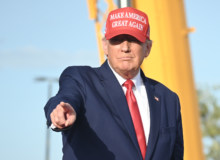The blue chip index went as high as 19,015 shortly after the opening bell, and the S & P 500 and Nasdaq are also at record highs.
Since Barack Obama took office and the Dow was touching lows of 7900, it has been, to say the least, a roller coaster to the now more than 19,000 number.
Before Donald Trump was elected over such names as Hillary Clinton of the DNC, Gary Johnson of the Libertarian Party and Evan McMullin of the Independent party, the Dow had kissed both highs and lows over a 9 day period within the last two weeks of the election cycle.
“Ironically enough, the market rallied sharply the Monday before Election Day after FBI Director James Comey cleared Clinton — an event that many investors interpreted as a sign that Clinton would wind up defeating Trump after all.” By CNN Money.
Hoping Trump will get a stimulus package passed that will rebuild the nation’s infrastructure is likely impacting the stock market. That’s why stocks like Caterpillar (CAT) and U.S. Steel (X) have surged since the election. The market also believes that Trump may roll back some of the provisions of two signature laws passed during the Obama administration — the Affordable Care Act and the Dodd-Frank Wall Street Reform and Consumer Protection Act. Drug makers like Merck (MRK) and Pfizer (PFE) have rallied higher on the hope that the new Trump Administration will not spend so much time on trying to rein in the prices of medications as the current Obama administration.
Since 1928, the Standard & Poor’s 500—a widely watched benchmark of U.S. large-cap companies—has dropped an average of 2.8% in presidential election years. By contrast, in years when the sitting president is up for reelection, the S&P 500 has averaged returns of 12.6%, (The average for all years from 1928 through 2014 is 7.5%.).
Bush entered office with the Dow Jones Industrial Average at 10,587, and the average peaked in October 2007 at over 14,000. When Bush left office, the average was at 7,949, one of the lowest levels of his presidency. Unemployment originally rose from 4.2 percent in January 2001 to 6.3 percent in June 2003, but subsequently dropped to 4.5 percent as of July 2007. Bush took office during a period of economic recession in the wake of the bursting of the Dot-com bubble. The terrorist attacks also impacted the economy. The Bush administration increased federal government spending from $1.789 trillion to $2.983 trillion (60 percent) while revenues increased from $2.025 trillion to $2.524 trillion (from 2000 to 2008). Individual income tax revenues increased by 14 percent, corporate tax revenues by 50 percent, customs, and duties by 40 percent. Discretionary defense spending was increased by 107 percent, discretionary domestic spending by 62 percent, Medicare spending by 131 percent, social security by 51 percent, and income security spending by 130 percent.
Government spending has had its ups and downs over the last few presidents, but the economy has seen an unfinished roller-coaster ride to the current low that every individual feels when they receive their paychecks. With a new President and an insecurity of what the future may bring, one can state without hesitation that the Dow, Nasdaq and S & P are rising out of a hope and a prayer. Over the next several months one can then start to place each piece of the puzzle to see what an economy under Donald Trump will look like.
Tags: Barack Obama Donald Trump Economy




















Join the conversation!
We have no tolerance for comments containing violence, racism, vulgarity, profanity, all caps, or discourteous behavior. Thank you for partnering with us to maintain a courteous and useful public environment where we can engage in reasonable discourse.